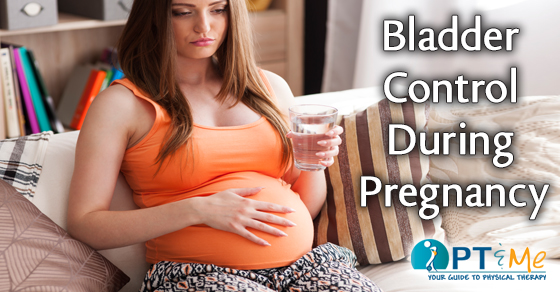Aside from a growing belly, you may notice other changes in your body now that you are pregnant. One thing you may notice is the loss of urine when you are not trying to urinate. Loss of bladder control, also called incontinence, is common during pregnancy and after childbirth. Needing to run to the bathroom often or leaking urine can make you feel embarrassed. Do not feel shy about asking for physical therapy for incontinence. They can help you understand and manage bladder control, and make sure there are not other conditions causing your incontinence. Here is some information to help you learn more.
HOW DOES THE BLADDER WORK?
Urine is stored in your bladder, which is an organ located in the pelvis. The muscles of the pelvis help keep your bladder in place. When you urinate, urine travels from your bladder and out of your body through a tube called the urethra. Ring-like muscles (sphincter muscles) keep the urethra closed so urine does not pass until you are ready to urinate. Muscles at the end of the urethra (sphincter muscles) and in the pelvic floor also help to hold back urine.
HOW CAN BEING PREGNANT CAUSE BLADDER CONTROL PROBLEMS?
The weight of a baby in your belly and the act of giving birth will put pressure on your bladder and may cause your pelvic muscles to stretch and weaken. This causes your bladder to sag, and your urethra to stretch. Nerves can also be damaged. It is this damage to muscles and nerves that can cause bladder control problems to persist.
HOW CAN I CONTROL MY BLADDER?
The good news is that incontinence may go away once your pelvic muscles heal, usually 6 weeks or so after giving birth. But you can take steps after childbirth to minimize bladder control problems by doing exercises to strengthen your pelvic floor muscles. Kegel exercises are one type of pelvic floor muscle exercise.
Kegel exercises do not require equipment and can be done anywhere—while sitting at your desk, standing in line at the bank, or even lying down in bed. They are done by squeezing your sphincter muscles in the same way you would when stopping urine flow. After 6-8 weeks of doing the exercises, you may find that you have fewer leaks.
Talk to your doctor to learn more about how to correctly do Kegel exercises. Following pregnancy, if Kegel exercises do not control the incontinence, your doctor may discuss other treatments or refer you to a specialist who can help.
Here are some general steps for doing Kegel exercises from the American Pregnancy Association:
• Squeeze your pelvic floor muscles as if you were trying to stop the flow of urine. Do not squeeze the muscles in your belly, legs, or buttocks.
• Hold for 5-10 seconds, then relax.
• Repeat 10-20 times.
• Try to do at least 3 sets per day.
If incontinence is still bothersome, talk to your doctor about other options, such as wearing absorbent pads or briefs. With support from your healthcare team, you will be able to manage incontinence, as well as other bodily changes that come with pregnancy.
by Marjorie Montemayor-Quellenberg, MA
RESOURCES:
American Congress of Obstetricians and Gynecologists
http://www.acog.org
Office on Women’s Health
http://www.womenshealth.gov
CANADIAN RESOURCES:
Health Canada
http://www.hc-sc.gc.ca
Women’s Health Matters
http://www.womenshealthmatters.ca
REFERENCES:
Kegel exercises. American Pregnancy Association website. Available at: http://americanpregnancy.org/labor-and-birth/kegel-exercises. Updated Aug. 2015. Accessed Feb. 10, 2016.
Treatments of common complaints in pregnant women. EBSCO DynaMed website. Available at: http://www.ebscohost.com/dynamed. Updated February 1, 2016. Accessed February 10, 2016.
Urinary incontinence fact sheet. Office on Women’s Health website. Available at: http://www.womenshealth.gov/publications/our-publications/fact-sheet/urinary-incontinence.html. Updated July 16, 2012. Accessed February 10, 2016.
Urinary incontinence in women. EBSCO DynaMed website. Available at: http://www.ebscohost.com/dynamed. Updated December 9, 2015. Accessed February 10, 2016.
What I need to know about bladder control for women. National Institute of Diabetes and Digestive and Kidney Diseases website. Available at: http://www.niddk.nih.gov/health-information/health-topics/urologic-disease/urinary-incontinence-women/Pages/ez.aspx. Updated June 2012. Accessed February 10, 2016.
3/5/2013 DynaMed’s Systematic Literature Surveillance: http://www.ebscohost.com/dynamed: Boyle R, Hay-Smith EJ, Cody JD, et al. Pelvic floor muscle training for prevention and treatment of urinary and faecal incontinence in antenatal and postnatal women. Cochrane Database Syst Rev. 2012;10:CD007471.
Last reviewed February 2016 by Michael Woods, MD Last Updated: 2/10/2016
EBSCO Information Services is fully accredited by URAC. URAC is an independent, nonprofit health care accrediting organization dedicated to promoting health care quality through accreditation, certification and commendation.


